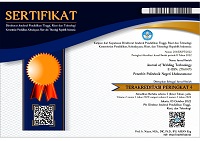The influence of prandtl number on flow characteristics of the fume from GMAW welding
Abstract
GMAW has become one of the most popular welding methods due to its high productivity in the manufacturing industry. However, there has been agrowing concern about the health effects of the fume produced by this welding method, as it may flow into the breathing zone of the welding operator.In this study, the impact of the Pr number on the behavior of the fume flow produced by GMAW was studied numerically using Computational Fluid Dynamics (CFD) simulation. Navier-Stokes and energy equations in two-dimensional axisymmetric coordinates were used to establish the numerical model for the GMAW fume flow.A transient finite-volume method with non-staggered mesh was applied to solve the numerical model. The numerical simulations were run 2.0 ≤ Pr ≤ 15.0 with other parameters kept constant at Fr = 5.5, Re = 100, and H/X0 = 10. The time series of the spreading distance plotted at various Prnumbers show different types of distances at different stages of the fume flow, the initial maximum, the maximum, and the final distances. When the Pr number is increased from 2.0 to 15.0.the gap between the initial maximum and the maximum distances decreases while the gap between the initial maximum and the final distances decreases.A nonlinear relationship was observed when the initial maximum and final distance data were plotted against the Pr number. The best fit for the initial maximum and the final distance data were obtained using the power of -1/2 and -2/3.
Keywords
Full Text:
PDFReferences
P. Kah, Advancements in Intelligent Gas Metal Arc Welding Systems: Fundamentals and Applications. Elsevier, 2021.
J. Juwanda, S. Saifuddin, and M. Marzuki, “Analisa pengaruh kuat arus hasil pengelasan GMAW terhadap kekerasan material ASTM A 36,” J. Weld. Technol., vol. 3, no. 1, pp. 6–11, 2021.
Z. Özdemir, “Effect of Shallow Cryogenıc Heat Treatment on Metal Inert Gas Weldıng Zone of S 355 J2 Steel,” J. Weld. Technol., vol. 5, no. 1, pp. 1–5, 2023.
M. Gonser and T. Hogan, “Arc welding health effects, fume formation mechanisms, and characterization methods,” Arc Weld., pp. 299–320, 2011.
T. Schoonover, L. Conroy, S. Lacey, and J. Plavka, “Personal exposure to metal fume, NO2, and O3 among production welders and non-welders,” Ind. Health, vol. 49, no. 1, pp. 63–72, 2011.
P. A. Orakwe, D. A. Johnson, and E. J. Weckman, “Examination of welding nozzle Jet flow at cold flow conditions,” in Fluids Engineering Division Summer Meeting, 2002, vol. 36169, pp. 3–11.
D. A. Johnson, P. Orakwe, and E. Weckman, “Experimental examination of welding nozzle jet flow at cold flow conditions,” Sci. Technol. Weld. Join., vol. 11, no. 6, pp. 681–687, 2006, doi: 10.1179/174329306X148200.
A. Godbole, P. Cooper, and J. Norrish, “Design and optimization of a novel on-torch fume extraction device using CFD and fluid simulation,” Weld. World, vol. 54, pp. R80–R86, 2010.
L. J. Bloomfield and R. C. Kerr, “Turbulent fountains in a stratified fluid,” J. Fluid Mech., vol. 358, pp. 335–356, 1998, doi: 10.1017/S0022112097008252.
L. J. Bloomfield and R. C. Kerr, “A theoretical model of a turbulent fountain,” J. Fluid Mech., vol. 424, pp. 197–216, 2000, doi: 10.1017/S0022112000001907.
W. Lin and S. W. Armfield, “Direct simulation of weak axisymmetric fountains in a homogeneous fluid,” J. Fluid Mech., vol. 403, pp. 67–88, 2000, doi: 10.1017/S0022112099006953.
W. Lin and S. W. Armfield, “The Reynolds and Prandtl number dependence of weak fountains,” Comput. Mech., vol. 31, no. 5, pp. 379–389, 2003, doi: 10.1007/s00466-003-0440-5.
W. Lin and S. W. Armfield, “Onset of entrainment in transitional round fountains,” Int. J. Heat Mass Transf., vol. 51, no. 21–22, pp. 5226–5237, 2008, doi: 10.1016/j.ijheatmasstransfer.2008.02.047.
W. Lin and S. W. Armfield, “Weak fountains in a stratified fluid,” Phys. Rev. E - Stat. Physics, Plasmas, Fluids, Relat. Interdiscip. Top., vol. 66, no. 6, p. 10, 2002, doi: 10.1103/PhysRevE.66.066308.
N. Williamson, S. W. Armfield, and W. Lin, “Transition behaviour of weak turbulent fountains,” J. Fluid Mech., vol. 655, pp. 306–326, 2010, doi: 10.1017/S002211201000087X.
N. Williamson, S. W. Armfield, and W. Lin, “Forced turbulent fountain flow behaviour,” J. Fluid Mech., vol. 671, pp. 535–558, 2011, doi: 10.1017/S0022112010005872.
K. Kuruppu and C. J. Lemckert, “Plunging radius of water fountains following impact on a rigid surface,” in 7th Australasian Heat and Mass Transfer Conference, Townsville, Queensland, Australia, 2000, pp. 195–200.
D. M. Holstein and C. J. Lemckert, “Spreading of energetic submerged fountains impinging on a rigid surface,” in 14th Australasian Fluid Mechanics Conference, Adelaide University, Adelaide, Australia, 2001, pp. 10–14.
C. J. Lemckert, “Submerged fountains impinging on a smooth horizontal surface,” 2005.
C. J. Lemckert, “Spreading radius of fountains after impinging a free surface,” in Proceedings of the 15th Australasian Fluid Mechanics Conference, 2004, vol. 400, pp. 217–220.
N. Srinarayana, S. W. Armfield, and W. X. Lin, “Impinging plane fountains in a homogeneous fluid,” Int. J. Heat Mass Transf., vol. 52, no. 11–12, pp. 2614–2623, 2009, doi: 10.1016/j.ijheatmasstransfer.2009.01.009.
N. Srinarayana, S. W. Armfield, and W. Lin, “Laminar plane fountains impinging on a ceiling with an opposing heat flux,” Int. J. Heat Mass Transf., vol. 52, no. 19–20, pp. 4545–4552, 2009, doi: 10.1016/j.ijheatmasstransfer.2009.03.015.
Luthfi, “The influence of height on the spreading distance of axisymmetric jets impinging on a rigid surface,” J. Polimesin, vol. 20, no. 1, pp. 18–23, 2022.
K. V. Satheesh Kumar, P. Selvak umar, K. R. Uvanshankar, S. Thirunavukarasu, V. Vijay Anand, and D. Vishal, “Investigation on the effect of technological parameters on emission factor in 316l stainless steel using gas metal arc welding,” Arch. Metall. Mater., vol. 66, no. 2, pp. 609–615, 2021, doi: 10.24425/amm.2021.135898.
W. Lin and S. W. Armfield, “Direct simulation of fountains with intermediate Froude and Reynolds numbers,” ANZIAM J., vol. 45, p. 66, 2004, doi: 10.21914/anziamj.v45i0.873.
DOI: http://dx.doi.org/10.30811/jowt.v5i2.4024
Refbacks
- There are currently no refbacks.

This work is licensed under a Creative Commons Attribution-ShareAlike 4.0 International License.
Ciptaan disebarluaskan di bawah Lisensi Creative Commons Atribusi-BerbagiSerupa 4.0 Internasional.
Mailing Address:
Politeknik Negeri Lhokseumawe
Jl. Banda Aceh-Medan
Km. 280,3, Buketrata, Mesjid Punteut, Blang Mangat,
Kota Lhokseumawe, 24301
Propinsi Aceh,
Indonesia























